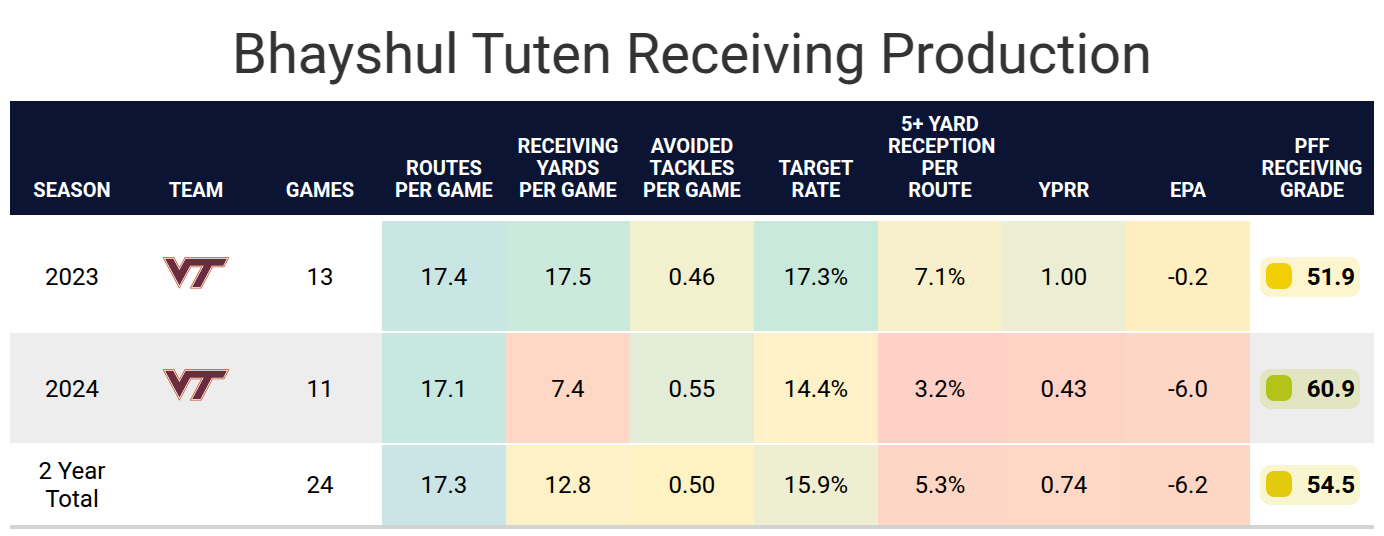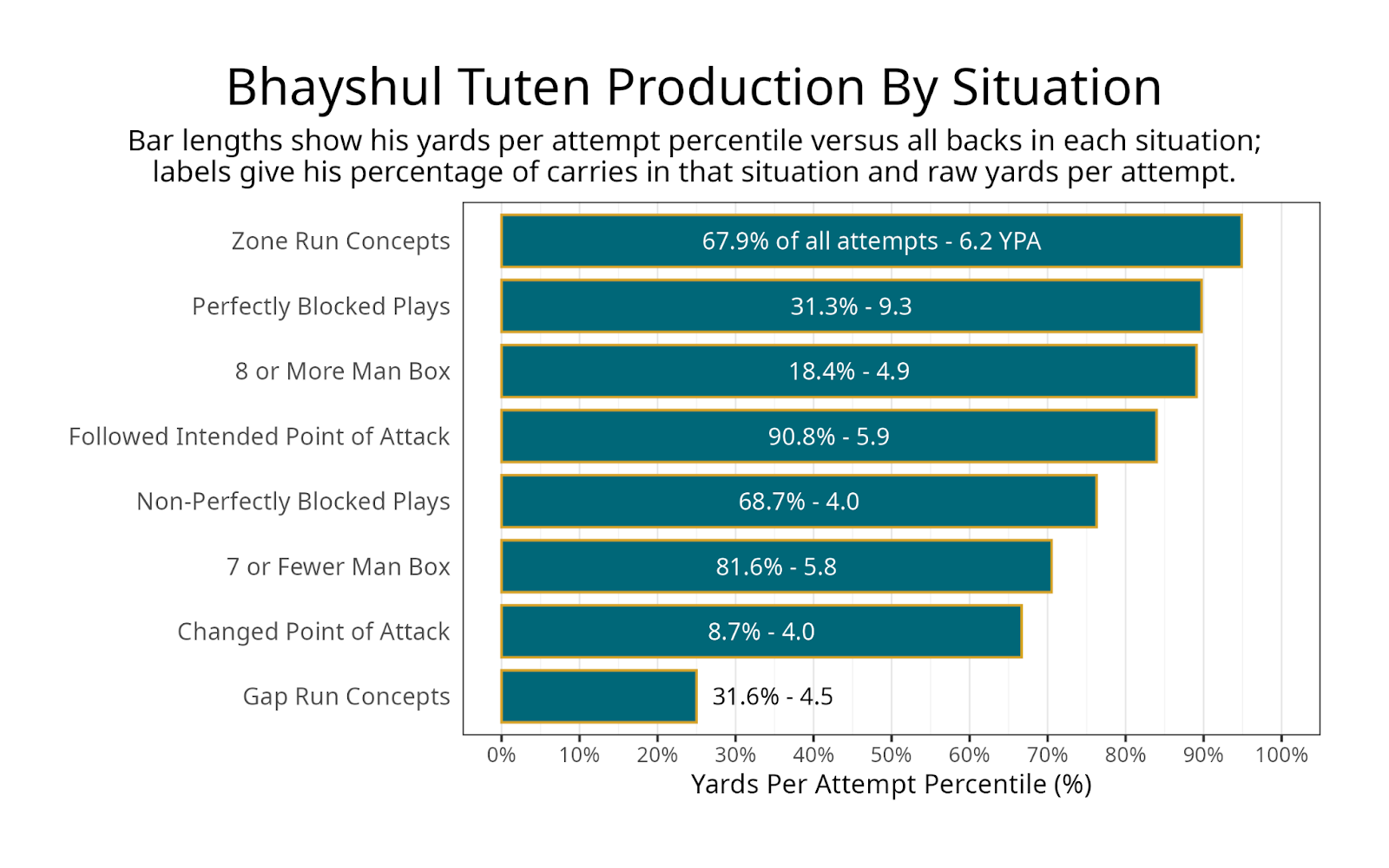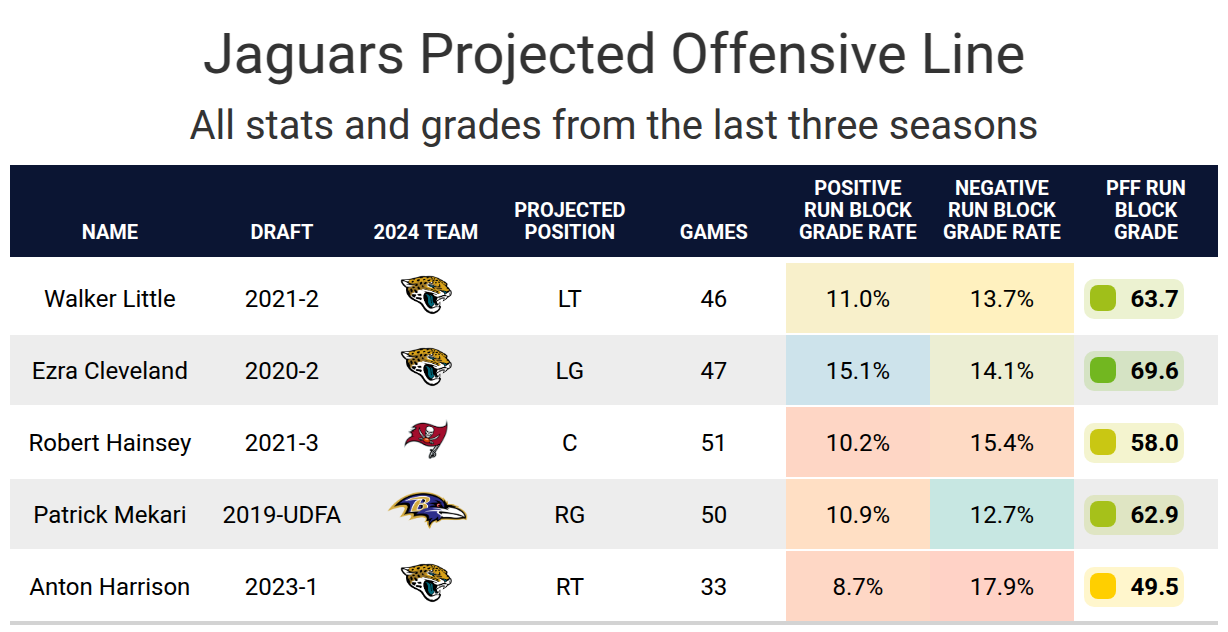- Bhayshul Tuten went from a zero-star recruit to NFL prospect: Tuten started his college career in the FCS and worked his way to becoming a fourth-round pick in the NFL draft.
- Excellent from a measurable standpoint: He ranked in the 88th percentile or better among running backs in most combine events.
- Subscribe to PFF+: Get access to player grades, PFF Premium Stats, fantasy football rankings, all of the PFF fantasy draft research tools and more!
Estimated Reading Time: 5 minutes

PFF’s Fantasy Football Player Profile series delivers the most in-depth fantasy football analysis available for the 2025 season.
Using PFF’s exclusive data, we evaluate player performance, competition for touches and how teammates and coaching staffs will impact each player's fantasy football outlook.
Last updated: 5:00 p.m. Tuesday, June 10
Player performance
Bhayshul Tuten earned high grades during his first two collegiate years at North Carolina A&T before transferring to Virginia Tech. He has been the Hokies' lead running back in the last two seasons, although he has shared duties on third downs.
Tuten’s 86.7 career FBS rushing grade is the second-lowest among the top-11 consensus running backs, but he arguably had the least help from his offensive line. His 1.6 yards before contact per attempt were tied for the lowest among those 11 running backs. That likely hurt his ability to gain first downs, but he, at least, partially made up for it with his big-play ability. While Tuten posted a blazing-fast 4.32-second 40-yard dash at the combine, his top speeds based on PFF's tracking data have been merely average for a prospective NFL running back.
Tuten had the second-highest rate of zone plays from the top running backs and one of the most significant dropoffs between his rushing grade on zone plays compared to man. Tuten must also work on ball security before earning a substantial role in an offense after fumbling the ball nine times at Virginia Tech.



Projected role
Tuten joins a complicated Jacksonville Jaguars backfield, making it even more perplexing. Last season, the Jaguars utilized a three-back committee with Travis Etienne Jr., Tank Bigsby and D'Ernest Johnson. The team opted not to re-sign Johnson, and a new coaching staff means the rotation from last season isn’t very helpful in determining what will happen this season.
Etienne started his career, looking like a great runner with an 83.2 PFF run grade. His run grade has steadily declined (62.8 last season). Bigsby was the better runner, but his role in the passing game has been non-existent. Before Tuten’s arrival, it seemed like Bigsby could be Jacksonville’s early-down back while Etienne is the passing-down back. Etienne dealt with injuries last season, which potentially impacted his grades. This meant there was a chance of Etienne regaining his early-down role.
Tuten was a feature back at Virginia Tech, dominating snaps, particularly in short-yardage situations, and only playing roughly half of the third-down snaps. This suggests Tuten is more of a threat to Bigsby’s snaps. From a measurable standpoint, Tuten stands out from the other two backs, ranking in the 88th percentile or better in the 40-yard dash, 10-yard split, bench press, vertical jump, broad jump and 20-yard shuttle. New head coach Liam Coen was the offensive coordinator of the Tampa Bay Buccaneers, where Rachaad White was similarly athletic but as a bigger back. White was primarily a receiving back. The fact that Tuten was picked by the new regime and the others weren’t worked in his favor, but being a fourth-round pick works against him.
Until we have more clarity on how snaps will be distributed between the three running backs, drafting any of them is a gamble.

Impact of teammates
Tuten will have Liam Coen as his new offensive coordinator. There weren’t many similarities between his offense with the Los Angeles Rams and his offense with the Buccaneers. This includes how often he used zone and gap schemes. The Jaguars ran gap runs at a high rate last season and were relatively average in their success at both zone and gap schemes. At the very least, Coen showed a willingness to get a fourth-round pick involved with Bucky Irving last season. While Irving and Tuten are the same height and were fourth-round picks, there are also plenty of differences between the two backs.
The Jaguars were among the bottom-10 teams in offensive line run-blocking grade last season. On the bright side, left tackle Walker Little showed substantial improvement over his first three seasons and has become a bright spot on the line. The Jaguars added Robert Hainsey and Patrick Mekari in free agency, who will both likely be starters. Both players are notably better pass protectors than run blockers. Tuten’s experience playing behind a subpar offensive line in college should help him transition to the Jaguars.


Bottom L;ne
Tuten should be viewed more favorably than most handcuff running backs. Like all handcuffs, there is a chance he won’t hold any fantasy value this upcoming season, but there is also a path for significant playing time if he can simply outperform the other running backs on the roster.
Footnotes
- Statistics in tables and charts were chosen based on their ability to predict future fantasy performance on a per-game or per-opportunity basis or to describe the player relative to others at the same position.
- “Opportunities” are defined as passing dropbacks, rushing attempts and routes run as a receiver.
- Numbers are provided either by season or based on the past three years. For rookies, only college statistics are included. For non-rookies, only NFL statistics are considered, regardless of whether they played in college within the previous three years.
- As college competition is easier than NFL competition, most rookies are likely to see a decline from their historical numbers.
- Only FBS data is considered for college players and comparisons.
- Kneel-downs are removed from rushing data to provide cleaner quarterback rushing rate statistics.
- The table colors in this article range from blue (indicating good/high) to red (indicating bad/low).
- All percentiles and color codings compare the given player to others with a high sample of opportunities. Generally, the cutoff is one-third of the possible opportunities in the sample. If a player does not meet the threshold, they are still included in the comparison, though their results may appear better or worse than expected due to the smaller, less predictive sample size.
- Information on utilization classifications and their importance can be found here for running backs, wide receivers and tight ends.



 © 2025 PFF - all rights reserved.
© 2025 PFF - all rights reserved.